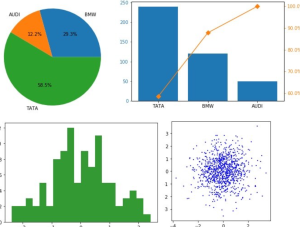
As a data scientist, you know that one of the most important aspects of your job is statistical analysis. After all, without accurate data, it would be impossible to make sound decisions about your company’s direction. Thankfully, there are a number of excellent Python statistical analysis packages available that can make your job much easier. In this blog post, we’ll take a look at some of the most popular ones.
SciPy
SciPy is a Python-based ecosystem of open-source software for mathematics, science, and engineering. SciPy contains modules for statistics, optimization, linear algebra, integration, interpolation, special functions, Fourier transforms (FFT), signal and image processing, and other tasks common in science and engineering. The core SciPy library is focused on numerical algorithms and procedural runtime functionality; it generally does not depend on any third-party libraries.
Scipy.stats package provide methods to work with following statistical concepts:
- Random variables
- Probability distributions
- One sample and two sample analysis including comparisons
- Kernel density estimation
- Quasi-Monte Carlo
Statsmodels
Statsmodels is a Python package that provides a set of tools for statistical analysis and econometric modeling. It includes tools for performing various statistical tests, as well as linear regression and time series analysis. Statsmodels can be used for both exploratory data analysis and formal hypothesis testing. It provides modules to work with some of the following:
- Regression and linear models
- Time series analysis
- Statistical tools such as probability distributions, contingency table, etc
NumPy
NumPy is a Python package that is typically used for scientific computing. It includes a powerful N-dimensional array object, as well as a set of tools for working with these arrays. NumPy can be used for a variety of statistical analyses, including mean, median, and mode calculation, as well as linear algebra and Fourier transforms.
Pandas
Pandas is a Python package that provides high-performance data structures and tools for data analysis. It includes a powerful dataframe object that can be used to store and manipulate data in a variety of ways. Pandas also provides a set of tools for performing statistical analyses on dataframes, including mean, median, and mode calculation, as well as linear regression.
Matplotlib / Seaborn
Matplotlib is a Python package that is commonly used for plotting data. It provides a number of functions that can be used to create various types of plots, including scatter plots, line plots, and bar charts. Matplotlib can also be used to plot data in 3D.
Seaborn is a Python package that is built on top of matplotlib. It provides a higher-level interface for creating for drawing attractive and informative statistical plots, including heatmaps, time series plots, and Violin plots. Seaborn also makes it easy to create complex multi-plot figures.
Conclusion
In this blog post, we’ve introduced you to some of the most popular Python statistical packages. These include SciPy, Statsmodels, NumPy, Pandas and Seaborn. Each of these packages has its own strengths and weaknesses, so it’s important to choose the right tool for the job. If you have any questions about which package is best for your data analysis needs, don’t hesitate to reach out to us. We love talking data and helping people find the best ways to use Python for their analysis needs. We’d be happy to help!
- Coefficient of Variation in Regression Modelling: Example - November 9, 2025
- Chunking Strategies for RAG with Examples - November 2, 2025
- RAG Pipeline: 6 Steps for Creating Naive RAG App - November 1, 2025
I found it very helpful. However the differences are not too understandable for me